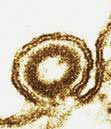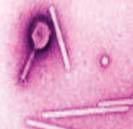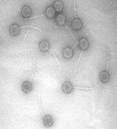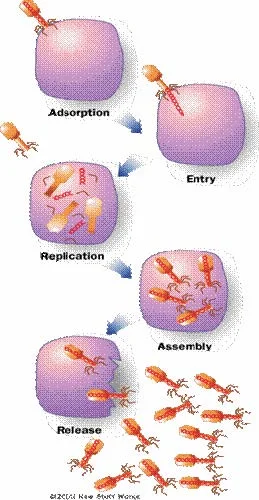VIRUSES FACT SHEET
What are Viruses?
Most of us have had the flu or a cold at least once in our lives so it’s easy to remember how terrible we feel when we’re sick. How could we forget the coughing, sneezing, upset stomachs, sore throats and fever? It is hard to believe that a virus particle 100 times smaller than a single bacteria cell (which is more than 10 times smaller than a human cell that is ten times smaller than the diameter of a single human hair) can make you feel so miserable. It is even more incredible when we consider that the viruses themselves are not even alive! How can something so small and dead make us miss a day of work or school? How can they cause so much trouble? If you keep reading you’ll find out!
Three different viruses as seen under an electron microscope
Viruses are nothing like human cells and bacterial cells. They are so small that we can’t even see them with a regular microscope! Being only one-millionth of an inch long, they cannot eat, grow or multiply on their own; they depend on the cells of the human body to do all these things for them. They will even infect bacteria cells in order to reproduce! Why do we let viruses take over our cells if they only want to make us sick? It is not really the body’s decision to make - the virus particles, or virions, attack it. The viruses ‘hi-jack’ the cells and use the machinery of the cells to carry out their own plans. An infected cell will produce viral particles instead of its usual products. Outside of a host cell (human, bacteria or plant cell) viruses can’t function; therefore they depend on others to carry out their job for them.
A Virion (Virus Particle) has Three Main Parts
1. Nucleic acid – The set of genetic instructions, either DNA or RNA that holds all of the information for the virus and that makes each type of virus unique.
2. Protein Coat (capsid) – This surrounds the nucleic acid and protects it.
3. Lipid membrane (envelope) – This surrounds the protein coat. Not all viruses have an envelope however. The ones that do are called enveloped viruses and the ones that don’t are called naked viruses.
Notice how this picture has spikes on the envelope. This is just one example of how different each virus looks. Not all viruses have spikes, and not all viruses are round. Many viruses are multi-sided and while some are oval, like the one in the picture, others may be rectangular with round corners, long and skinny, or looped like a piece of string. Some may look like a spider, or even like the Apollo Lunar Lander. When it comes to viruses, there’s no telling what they may look like!
Diagrams of Different Viruses
Lunarphage - (the 'Apollo Lunar Lander')
Other virus morphologies (shapes)
How Does a Virus Infect Me?
We already know that viruses do not have the chemical machinery needed to survive on their own, so instead they must have host cells in which to live and make more viruses. How do they actually get into our bodies to use our cells as hosts? Let’s find out…
Viruses are everywhere in the environment (from soil to water to air) waiting for a host cell to come along. Viruses can enter our bodies through our nose, mouth, or any breaks in the skin like a paper cut or a scratch. Once they make it inside, they search around for a cell to infect. A cold or flu virus will target cells that line the respiratory (i.e. the lungs) or digestive (i.e. the stomach) tracts. The HIV (human immunodeficiency virus) that causes AIDS attacks the T-cells (a type of white blood cell that fights infection and disease) of the immune system. Regardless of the type of host cell, all viruses follow the same basic steps to infection, something that is called the lytic cycle.
The lytic cycle has six basics steps:
1. A virus particle attaches to a host cell (ADSORPTION).
2. The particle injects its genetic instructions (DNA or RNA) into the host (ENTRY).
3. The injected genetic material ‘hi-jacks’ the cell’s machinery and recruits the host’s enzymes.
4. The enzymes make parts for the new virus particles (REPLICATION).
5. The new particles assemble the parts into new viruses (ASSEMBLY).
6. The new viruses kill the cell so that they may break free and search for a new host cell to continue the cycle (RELEASE).
In the lytic cycle, the virus reproduces itself using the host cell’s chemical machinery. The red spiral lines in the drawing indicate the virus’s genetic material. The orange portion is the outer shell that protects it).
One viral particle from the environment gets into my body somehow and
then makes more particles that make me sick?? Confused? This example of
how you get sick with a cold should help.
All viruses have some type of protein on the outside protein coat or envelope so they can choose the right host cell to infect. These proteins allow them to recognize the right one. For example, a cold virus would not want to attach to the stomach, because it wouldn’t be able to infect you that way, but rather searches for a nasal lining cell so that it may replicate and start causing the symptoms of a cold. The protein on the outside of the virus attaches it to the membrane of the desired host cell so that it may start the infection process. One virus is able to produce thousands of new viral particles (as seen in the above diagram) so viral infections are able to spread quickly throughout the body.
1. An infected person (a person with a cold) sneezes near you, without covering their mouth. Eww!
2. You breathe in the virus particle, and it attaches to the cells lining the sinuses in your nose (by using its special membrane proteins to recognize and attach to the right cell).
3. The virus attacks the cells lining the sinuses and quickly makes new viral particles inside the host cells.
4. The host cells break and the new viruses can then spread in your body – into your bloodstream and to your lungs. Because you have lost cells lining your sinuses, fluid can flow into your nasal passages and give you a runny nose.
5. Viruses in the fluid that drips down your throat can attack the cells lining your throat. This is how you’ll get a sore throat.
6. Viruses in your bloodstream can attack muscle cells and cause you to have muscle aches.
I’m Sick With a Virus… What do I do Now?
When you’re infected with a virus, you have a bunch of ‘foreign particles’ roaming around inside you. Your immune system recognizes these invaders and produces antibodies. Antibodies are proteins that bind to the viral particles and prevent them from attaching to new cells, therefore stopping them from further replication. The immune system can also detect infected cells and sends white blood cells to destroy them before more viral particles are released. This immune response continues until all of the viral particles are eliminated from your body.
Are There Medicines that Can Help Me?
Even though many people think that taking antibiotics will help you if you have a viral infection, this is not the case. Antibiotics work by interfering with the reproduction of new cells, but as we’ve already learned, viruses do not themselves make new cells, so antibiotics can’t stop them from reproducing.
Although antibiotics don’t help, there are immunizations that will. Immunizations, also called vaccines, work by pre-infecting your body so it will recognize the viral particles and be able to destroy them as soon as they enter the body. Since there are so many different types of viruses and because they are always changing, new vaccines are always being created to make sure that the viruses don’t get out of control.
How Can I Stop Spreading a Virus?
We know that viruses can live for a long time outside of a host, waiting for a perfect opportunity of infection to come along. The way a virus spreads is different for each type of virus. Some spread through the air, while others may travel in a carrier organism (flea, mosquito), spread by direct transfer of bodily fluids (blood, sweat, saliva, mucus) or can be found on surfaces on which body fluids have dried. Some viruses may even be present in water sources such as rivers, ponds, lakes and wells. The water may look clean and clear, but remember how small viruses are… we wouldn’t be able to see them even if they were there!
To reduce the risk of spreading or getting a virus, try to do the following:
• Cover your mouth or nose when you cough or sneeze.
• Wash your hands often, especially after going to the bathroom, blowing your nose and before eating or preparing food.
• Avoid contact with the bodily fluids of others. For example, do not share a toothbrush or a water glass with others.
• Do not drink untreated water from sources that may be contaminated.
By following these simple suggestions, you lessen the chances a virus has to sneak inside of you and, therefore, reduce the risk of letting a virus make you sick!
Did you know that our Operation Water Health program is a free program available to teachers worldwide that provides them with all of the lesson plans and information they need to teach their students what safe drinking water is, what unsafe drinking water is, and the health problems that can be caused by unsafe drinking water? Please help us to keep our Operation Water Health program updated! Please chip in $5 or donate $20 or more and receive an Official Donation Receipt for Income Tax Purposes.










